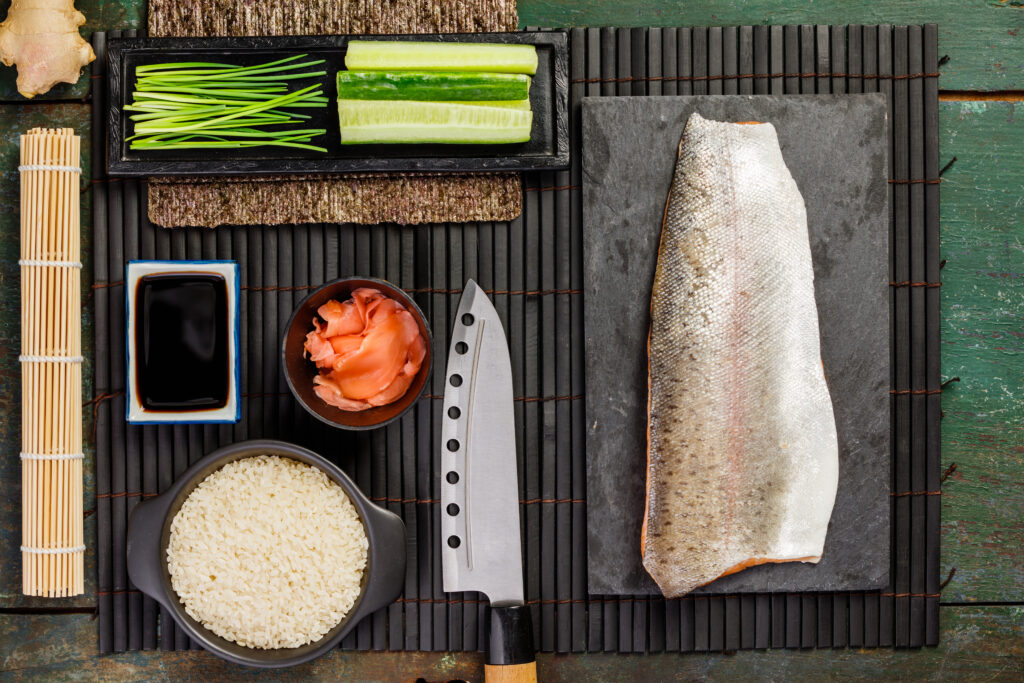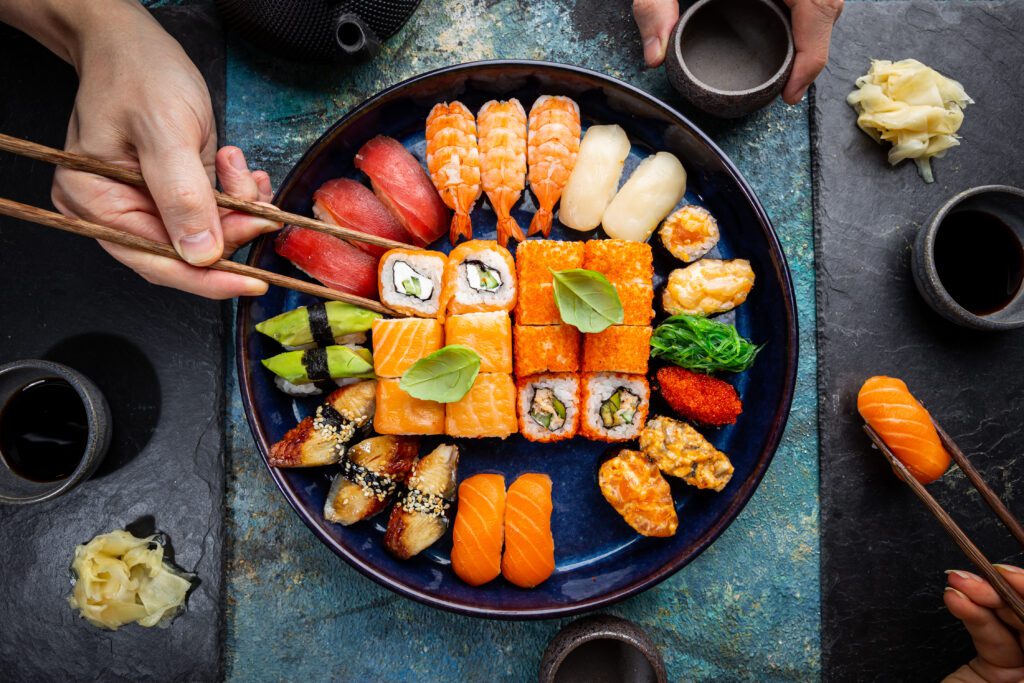Is there anything more satisfying than that first bite of sushi? The beauty of this delicacy lies not just in its combination of rice, fish, and vegetables but also in the meticulous techniques used to roll, shape, and present each delectable piece. Your mouth might be watering just at the thought, I know mine is. So, if you’re sitting at home wondering how to roll sushi like a pro, then you’ve come to the right place.
Learning how to roll sushi is an art, and like most things, it takes practice to make it perfectly. But, fear not. Our step-by-step guide is beginner-friendly, so you’ll be an expert in no time. From selecting the finest ingredients to mastering the art of precision cutting, each element contributes to the creation of a culinary masterpiece that tantalizes the taste buds.
So, grab your bamboo rolling mat, sharpen your knives, and let’s dive right in!
A Brief History of Sushi
While the word “sushi” is now synonymous with the delicate combination of vinegared rice and fresh fish, its origins can be traced back to ancient times when it served as a preservation method.
In the 8th century, Japanese households began fermenting rice with salted fish, creating a dish known as “narezushi.” Over time, this evolved into “nigirizushi” in the Edo period (1603-1868), where hand-pressed rice and fish were served together. The introduction of rice vinegar in the 17th century revolutionized sushi, which led to the development of “edomaezushi,” the precursor to modern sushi.
With the advent of refrigeration in the 20th century, sushi underwent further evolution. Today, sushi has become a global culinary phenomenon, celebrated not only for its exquisite taste but also as a symbol of precision, artistry, and cultural heritage.
Now that you have a little background on the history of sushi, it’s time to gather your ingredients to learn how to roll sushi.
Sushi Ingredients
From the freshest seafood to carefully selected vegetables, each ingredient plays a crucial role in creating the perfect roll. Below are the common ingredients for sushi rolls.
- Sushi Rice
- Nori (Seaweed)
- Sashimi-grade Fish (such as tuna and salmon)
- Vegetables (e.g., cucumber, avocado, and carrot)
- Soy Sauce
- Wasabi
- Pickled Ginger (gari)
- Sesame Seeds
- Rice Vinegar
- Mirin (sweet rice wine)
- Soy Paper (alternative to seaweed for rolls)
- Tobiko (fish roe)

Different Types of Sushi
There are a few different kinds of sushi that you might be familiar with, so we’re going to break them down for you.
Nigiri
First up is nigiri. Nigiri sushi consists of hand-pressed mounds of vinegared rice crowned with a thin slice of fresh, high-quality fish or seafood. This minimalist delicacy allows the purity of each ingredient to shine.
Sashimi
Sashimi, though not technically sushi, is often enjoyed alongside it. This dish features thinly sliced raw fish or seafood, skillfully arranged and served without rice. The emphasis here is on the pure, unadulterated taste of the seafood.
Maki
Popularly known, maki rolls are perhaps the most recognized form of sushi. These rolls feature a combination of rice, seaweed, fish, and vegetables, all tightly wrapped and sliced into bite-sized pieces. Varieties range from the classic California roll to inventive creations with diverse fillings.
Temaki
Temaki, or hand rolls, are cone-shaped sushi wrapped in seaweed and filled with rice, fish, and vegetables. They are meant to be eaten with the hands, providing a more interactive and casual dining experience.
Uramaki
Next up is uramaki, also known as inside-out rolls. It features rice on the outside of the seaweed, with the filling in the center. This style allows for creative combinations and often incorporates toppings like avocado, sesame seeds, or tobiko.
Chirashi
Chirashi sushi is a bowl of vinegared rice topped with a colorful assortment of sashimi-grade fish, vegetables, and other garnishes. The name “chirashi” translates to “scattered,” highlighting the artistic arrangement of ingredients.
Oshi
Lastly, oshi sushi involves pressing layers of rice, fish, and other toppings into a rectangular mold to create a compressed and visually appealing sushi block. This style is particularly popular in Osaka.
As you can see, there are many types of sushi to explore. For the sake of simplicity, we’re going to discuss how to roll maki sushi.

How to Roll Sushi in 6 Easy Steps
Rolling sushi is an art that combines precision, creativity, and a touch of finesse. Follow these steps to embark on a journey that transforms simple ingredients into a delectable sushi masterpiece. Let’s get started!
1. Prepare the Sushi Rice
Begin by cooking high-quality sushi rice according to package instructions. Once cooked, gently fold in seasoned rice vinegar to achieve the characteristic sushi rice flavor. Then, allow it to cool to room temperature before moving on to the next step.
2. Slice the Fish and Veggies
Select your preferred fish and vegetables for the filling. Common fish used in sushi are salmon, tuna, yellowtail, crab, shrimp, and mackerel. Slice them into thin, uniform strips to ensure a harmonious blend of textures and flavors in every bite.
3. Assemble Ingredients on Nori
Now, it’s time to put them together. Place a sheet of nori (seaweed) on a clean, flat surface. With slightly wet hands, spread a thin layer of sushi rice evenly over the nori, leaving a small margin at the top to seal the roll.
4. Roll Sushi With a Bamboo Mat
Next, it’s the part you’ve all been waiting for! Time to rock and roll. Position your bamboo sushi rolling mat horizontally in front of you. Arrange the sliced fish and vegetables along the edge of the rice closest to you. Using the bamboo mat as a guide, carefully roll the nori and rice over the filling, applying gentle pressure to shape the roll.
5. Cut Into Bite-Sized Pieces
Once the roll is secured, transfer it to a cutting board. With a sharp, wet knife, slice the roll into bite-sized pieces. Wetting the knife prevents the rice from sticking and ensures clean cuts.
6. Plate Your Sushi
Finally, your sushi is ready to eat! Arrange the sushi pieces on a plate, taking care to showcase the vibrant colors and textures. Garnish with soy sauce, pickled ginger, and wasabi for an authentic sushi experience.
As you master the technique of how to roll sushi, feel free to explore different fillings, sauces, and presentations to create your signature rolls. With practice, you’ll not only savor the satisfaction of crafting your sushi but also delight in sharing this culinary art with others.

Enjoy a One-of-a-Kind Sushi Experience at Kobe Steakhouse
Still craving sushi, but don’t want to make it at home? Leave the sushi crafting to the experts and enjoy the delicious rolls at Kobe Steakhouse!
We invite you to experience the magic of our sushi firsthand. Whether you’re a seasoned sushi enthusiast or just beginning to discover the joys of this ancient culinary art, our chefs are dedicated to crafting an exceptional dining experience for you. Revel in the authentic flavors, meticulous preparation, and artful presentation that define our sushi offerings.
Book a reservation with us to indulge in a memorable dining experience where tradition meets innovation, or conveniently order online to enjoy the exquisite tastes of sushi in the comfort of your own home. Join us in celebrating the art of sushi at Kobe Japanese Steakhouse, where every roll tells a story, and every bite is a journey into the heart of Japanese culinary mastery.